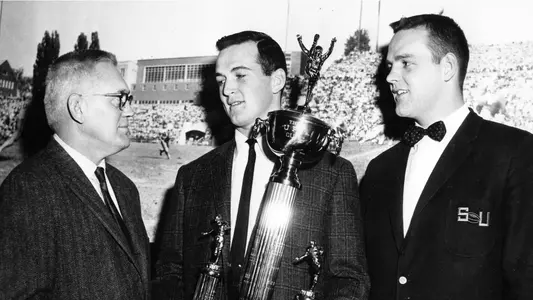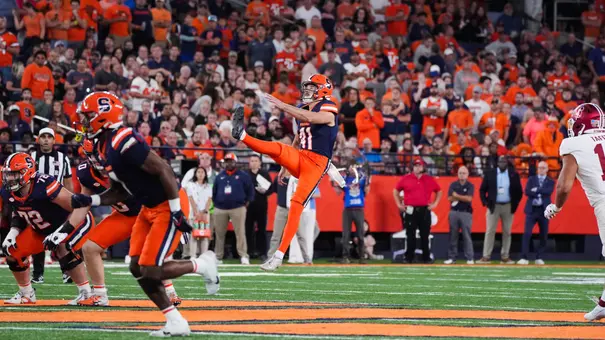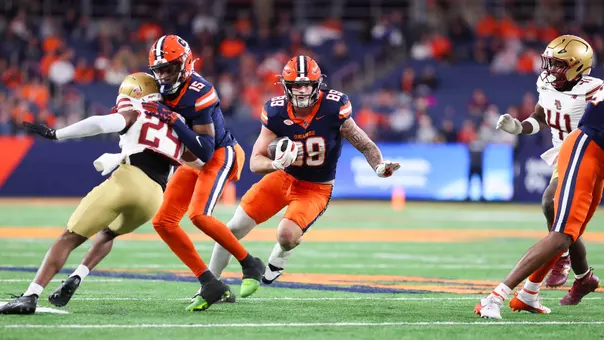
Syracuse's 1959 National Championship Team 'Had No Weaknesses'
8/27/2019 12:29:00 PM | Football
Editor's note: This story appears in all six editions of the 2019 Syracuse football gameday program. Programs are available for $5 and sold throughout the Dome.
The 1959 Syracuse football squad was the kind of team you make a movie about.
Sixty years ago, the Orange captured the program's only national championship behind future Heisman Trophy winner Ernie Davis and served as one of the main plotlines in the movie "The Express" based on Davis' life. Dominant, balanced and groundbreaking, Syracuse rolled to an 11-0 record, the first undefeated season in school history.
Led by College Football Hall of Fame coach Ben Schwartzwalder, the Orange were unranked to start the season, but climbed to No. 1 after winning their first seven games. While the team will be forever linked to offensive stars like Davis, consensus All-America guard Roger Davis, and fellow All-Americans Fred Mautino and Bob Yates, the defense more than held its own. Syracuse limited its 10 regular-season opponents to a remarkable 193 total rushing yards.
The Orange, under the guidance of Schwartzwalder, the ex-paratrooper who served in World War II, prided themselves on being a hard-nosed football team. The offensive and defensive lines – aptly dubbed "The Sizable Seven" – dominated the trenches.
"If you're not a hitter, you're not a hard-nose," said a Syracuse football player in the Jan. 11, 1960 issue of Life magazine. "And if you're not a hard-nose, you don't play for Benny."
Schwartzwalder's style was simple. Wear down the opponent.
"Usually," team captain Gerhard Schwedes said, "by the end of the second quarter."
The Orange were dominant in every statistical category. They led the NCAA in total offense (451.5 ypg), total plays (738), total offensive yards (4,515), rushing yards per game (313.6), completion percentage (.581), touchdown passes (21), scoring offense (39.0 ppg), total defense (96.2 ypg), rushing defense (19.3 ypg) and fewest yards allowed per carry (0.65).

"The most impressive thing about that team was their defense. It was one of the best I've ever seen or coached against in all my years," ESPN commentator Lee Corso said. Corso was the Maryland quarterbacks coach at the time.
"That team had a combination of power where they could stuff the run and enough speed that they could go sideline to sideline."
The Orange opened the season with a 35-21 win over Kansas that moved them into the national rankings. But it was a shutout of Corso's Terrapins – the first of five shutouts for the Orange defense on the year – that propelled them to No. 12 in the Associated Press poll.
From there, Syracuse rattled off wins over Navy, Holy Cross, West Virginia and Pitt before a road trip to Beaver Stadium and a showdown with Penn State.
In a battle of two undefeated teams, the seventh-ranked Nittany Lions struck first, taking a 6-0 lead and holding the fourth-ranked Orange scoreless in the first quarter. Schwedes scored in the second quarter and Yates kicked the extra point to give the Orange a 7-6 advantage.
That's how the score remained until a key fourth-down play in the third quarter. Quarterback Dave Sarette connected with fullback Art Baker for a 5-yard touchdown to put Syracuse ahead, 14-6. Ernie Davis scored from one yard out to extend the Syracuse advantage to 20-6, but Penn State returned the ensuing kickoff 100 yards for a touchdown. The extra point failed and Syracuse maintained a 20-12 lead.
Another big play by the Nittany Lions, this time a blocked punt recovered at the Syracuse 1-yard line, led to a touchdown and made the score 20-18. But that's as close as Penn State would get. Syracuse ran 10 plays on its next drive and held the ball until the clock ran out.
A few days later, Syracuse assumed the No. 1 ranking in both national polls for the first time in school history.
Playing as the top-ranked team in the land, Syracuse proved it was worthy of such praise. The Orange pummeled Colgate (71-0) and Boston University (46-0) by the combined score of 117-0 in subsequent weeks.
The regular season came to a close with a trip west to face UCLA. The Orange handled their final regular-season challenge with ease, defeating the Bruins 36-8 to improve to 10-0.
In those days, the national champion was declared before the bowl games and 10,000 screaming Orange fans showed up at Hancock Field to greet the newly-crowned kings of college football when they arrived home. However, there was still the matter of a Cotton Bowl showdown with No. 4 Texas. Everyone knew Syracuse would be considered a paper champion if it did not take care of business against the Longhorns.

The only remaining undefeated team in the country, Syracuse opened the scoring quickly as Schwedes completed an 87-yard touchdown pass to Ernie Davis. In the second quarter, Syracuse drove 80 yards and Davis scored his second TD of the day, this time from a yard out. The Orange superstar then caught the two-point conversion to increase the Syracuse advantage to 15-0.
Texas got on the board in the third quarter, but it was Davis' day. He intercepted a Texas pass and returned it to the Longhorns' 24-yard line to set up the Orange's final touchdown. Schwedes punched it in from the 3-yard line and Sarette found Davis for another two-point conversion to give the Orange a 23-6 lead.
The final score ended up 23-14 and Davis was named the game's MVP. The victory erased any doubt about who the best college football team was in 1959. Syracuse was voted the national champion by 15 selectors, including the Associated Press and United Press International wire services.
Beyond the stats and records, perhaps the 1959 team's biggest contribution was helping break down racial barriers in college football. Davis – the first African-American to win the Heisman Trophy – was the team's star player as a sophomore. The two-time consensus All-American was selected with the No. 1 pick in the 1962 NFL Draft by the Washington Redskins and traded to Cleveland before dying of leukemia a year later. He, John Brown and Syracuse's other African-American players endured constant racial epithets, but persevered.
The 1959 Orange are frequently mentioned with Bud Wilkinson's Oklahoma Sooners, the great Army teams led by Glenn Davis and Doc Blanchard, and the 1971 Nebraska Cornhuskers as one of the greatest college football teams of all-time.
Said Corso: "They had no weaknesses."
For complete coverage of Syracuse football, follow us on Twitter (@CuseFootball), Instagram (@CuseFootball) and like us on Facebook (Syracuse Football).
The 1959 Syracuse football squad was the kind of team you make a movie about.
Sixty years ago, the Orange captured the program's only national championship behind future Heisman Trophy winner Ernie Davis and served as one of the main plotlines in the movie "The Express" based on Davis' life. Dominant, balanced and groundbreaking, Syracuse rolled to an 11-0 record, the first undefeated season in school history.
Led by College Football Hall of Fame coach Ben Schwartzwalder, the Orange were unranked to start the season, but climbed to No. 1 after winning their first seven games. While the team will be forever linked to offensive stars like Davis, consensus All-America guard Roger Davis, and fellow All-Americans Fred Mautino and Bob Yates, the defense more than held its own. Syracuse limited its 10 regular-season opponents to a remarkable 193 total rushing yards.
The Orange, under the guidance of Schwartzwalder, the ex-paratrooper who served in World War II, prided themselves on being a hard-nosed football team. The offensive and defensive lines – aptly dubbed "The Sizable Seven" – dominated the trenches.
"If you're not a hitter, you're not a hard-nose," said a Syracuse football player in the Jan. 11, 1960 issue of Life magazine. "And if you're not a hard-nose, you don't play for Benny."
Schwartzwalder's style was simple. Wear down the opponent.
"Usually," team captain Gerhard Schwedes said, "by the end of the second quarter."
The Orange were dominant in every statistical category. They led the NCAA in total offense (451.5 ypg), total plays (738), total offensive yards (4,515), rushing yards per game (313.6), completion percentage (.581), touchdown passes (21), scoring offense (39.0 ppg), total defense (96.2 ypg), rushing defense (19.3 ypg) and fewest yards allowed per carry (0.65).

"The most impressive thing about that team was their defense. It was one of the best I've ever seen or coached against in all my years," ESPN commentator Lee Corso said. Corso was the Maryland quarterbacks coach at the time.
"That team had a combination of power where they could stuff the run and enough speed that they could go sideline to sideline."
The Orange opened the season with a 35-21 win over Kansas that moved them into the national rankings. But it was a shutout of Corso's Terrapins – the first of five shutouts for the Orange defense on the year – that propelled them to No. 12 in the Associated Press poll.
From there, Syracuse rattled off wins over Navy, Holy Cross, West Virginia and Pitt before a road trip to Beaver Stadium and a showdown with Penn State.
In a battle of two undefeated teams, the seventh-ranked Nittany Lions struck first, taking a 6-0 lead and holding the fourth-ranked Orange scoreless in the first quarter. Schwedes scored in the second quarter and Yates kicked the extra point to give the Orange a 7-6 advantage.
That's how the score remained until a key fourth-down play in the third quarter. Quarterback Dave Sarette connected with fullback Art Baker for a 5-yard touchdown to put Syracuse ahead, 14-6. Ernie Davis scored from one yard out to extend the Syracuse advantage to 20-6, but Penn State returned the ensuing kickoff 100 yards for a touchdown. The extra point failed and Syracuse maintained a 20-12 lead.
Another big play by the Nittany Lions, this time a blocked punt recovered at the Syracuse 1-yard line, led to a touchdown and made the score 20-18. But that's as close as Penn State would get. Syracuse ran 10 plays on its next drive and held the ball until the clock ran out.
A few days later, Syracuse assumed the No. 1 ranking in both national polls for the first time in school history.
Playing as the top-ranked team in the land, Syracuse proved it was worthy of such praise. The Orange pummeled Colgate (71-0) and Boston University (46-0) by the combined score of 117-0 in subsequent weeks.
The regular season came to a close with a trip west to face UCLA. The Orange handled their final regular-season challenge with ease, defeating the Bruins 36-8 to improve to 10-0.
In those days, the national champion was declared before the bowl games and 10,000 screaming Orange fans showed up at Hancock Field to greet the newly-crowned kings of college football when they arrived home. However, there was still the matter of a Cotton Bowl showdown with No. 4 Texas. Everyone knew Syracuse would be considered a paper champion if it did not take care of business against the Longhorns.

The only remaining undefeated team in the country, Syracuse opened the scoring quickly as Schwedes completed an 87-yard touchdown pass to Ernie Davis. In the second quarter, Syracuse drove 80 yards and Davis scored his second TD of the day, this time from a yard out. The Orange superstar then caught the two-point conversion to increase the Syracuse advantage to 15-0.
Texas got on the board in the third quarter, but it was Davis' day. He intercepted a Texas pass and returned it to the Longhorns' 24-yard line to set up the Orange's final touchdown. Schwedes punched it in from the 3-yard line and Sarette found Davis for another two-point conversion to give the Orange a 23-6 lead.
The final score ended up 23-14 and Davis was named the game's MVP. The victory erased any doubt about who the best college football team was in 1959. Syracuse was voted the national champion by 15 selectors, including the Associated Press and United Press International wire services.
Beyond the stats and records, perhaps the 1959 team's biggest contribution was helping break down racial barriers in college football. Davis – the first African-American to win the Heisman Trophy – was the team's star player as a sophomore. The two-time consensus All-American was selected with the No. 1 pick in the 1962 NFL Draft by the Washington Redskins and traded to Cleveland before dying of leukemia a year later. He, John Brown and Syracuse's other African-American players endured constant racial epithets, but persevered.
The 1959 Orange are frequently mentioned with Bud Wilkinson's Oklahoma Sooners, the great Army teams led by Glenn Davis and Doc Blanchard, and the 1971 Nebraska Cornhuskers as one of the greatest college football teams of all-time.
Said Corso: "They had no weaknesses."
For complete coverage of Syracuse football, follow us on Twitter (@CuseFootball), Instagram (@CuseFootball) and like us on Facebook (Syracuse Football).
Fran Brown Signing Day Press Conference
Wednesday, December 03
Syracuse Football - Signing Day Press Conference
Wednesday, December 03
Syracuse Football Postgame Press Conference
Saturday, November 29
Players Postgame vs. Boston College
Saturday, November 29




























